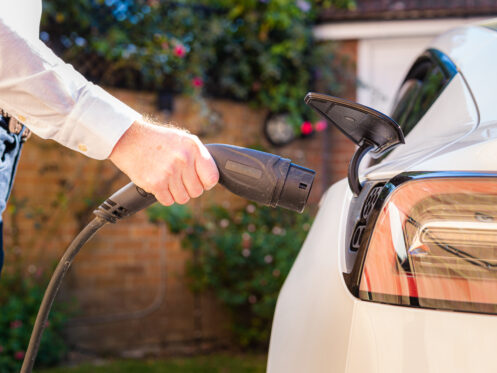As more people invest in electric vehicles in Dickinson, they are also seeking more convenient and accessible charging solutions. This leads to the question: Can EVs be charged via a dryer outlet? The answer might surprise you.
Many EV owners have claimed on social media platforms that they’re using dryer outlets to keep their vehicles running efficiently. They’re not necessarily wrong, either. Dryer outlets can be used to charge EVs, but this unconventional charging method might bring more challenges than benefits.
Dryer outlets are typically 240 volts, which is exactly the voltage needed for level 2 charging. Level 2 charging is faster than level 1 charging, which is completed through most of the 120-volt outlets installed in the average home. However, simply providing the right voltage for an EV does not mean it’s safe or smart to use your dryer outlet to charge your EV.
Why a Dryer Outlet is not the Best Idea to Charge Your EV
Charging an electric vehicle through your dryer’s outlet can affect other appliances and people, too, for many reasons.
First, dryers are not designed to be plugged and unplugged repeatedly. This can lead to cable damage over time and may increase your risk of a house fire. This is one reason dryers have dedicated outlets.
Another factor affecting the use of a dryer outlet for charging EVs is the amperage. Most 240-volt outlets will have an amperage rating of 30 to 50. If the car charger has a lower or higher amperage rating, you could find yourself struggling to fully charge your EV.
Next, dryer outlets aren’t designed for charging EVs and may not charge at the speed you’d like them to charge. If your car charger is level one rated, you can safely charge your EV using a dryer outlet, but the charging speed will be low. However, some cars like Tesla are designed to use superchargers with a level 3 rating. These chargers are fast DC chargers, which require a voltage of around 400.
Finally, adding extenders to charge your car could result in overloaded outlets. When an outlet is overloaded, the circuit breaker will sense the excess current, flipping a switch to protect the circuit. However, old or faulty equipment might not disrupt the current flow in time or at all, leading to the wires overheating, which could cause a fire.
How To Charge Your EV Safely
The safest way to charge your electric vehicle is through a EV charging station, which can be installed in your home. With this dedicated charger designed specifically for charging electric cars, you won’t have to unplug other appliances from the outlet and you can reduce the risk of damage to those appliances as well as to your home’s circuitry.
When you install a dedicated charging station at your home, you can choose the exact charging level you want and need based on your car’s specifications. In other words, a car using level three charging can use an outlet designed for fast, effective charging. A properly installed outlet for a specific charger will also be fully able to handle the flow of current, preventing overheating and reducing the risk of potential fires and other electrical hazards. You’ll have the freedom to charge one or many EVs with multiple outlets for family members and guests to charge their vehicles.
Finally, a well-designed home charging station could even increase your home’s value by making it more versatile and attractive to potential buyers.
What’s the Process of Installing an EV Charger at Home?
Home charging station installation is a complicated process that requires a technician. This is because you must have your home examined and decide the station location and the power needed for charging, depending on your car.
Here are the steps for installing an EV charger at home:
Step 1: Hire a certified electrician
A certified electrician who understands electric vehicles can save you from unexpected repair expenses due to poor workmanship. They understand the safety needs and will work on the project with home safety in mind.
Step 2: Obtain an EV charger installation permit
You wouldn’t install the EV charger without visiting the local electric company. A professional will examine your home to ensure its eligibility, check the wiring quality to determine whether it needs an upgrade, and could even help you to obtain the installation permit.
Step 3: Confirm your electric panel has a space for the circuit breaker
The electrical panel must have a space to accommodate the circuit breaker. A professional electrician will advise if the panel has no space. You can install a new one specifically for the EV charger circuit breaker.
Step 4: Choose your car charger
There are three types of electric car chargers. The first one is the level 1 charger. This charger uses the basic 120 volts outlets found in many homes. However, it’s the slowest of all chargers, taking up to two days to charge full electric vehicles. That’s why it’s designed for plug-in hybrid cars instead.
The second charger is level 2, commonly used in electric vehicles. Level 2 charging used outlets of between 208 volts and 240 volts. Unlike the level 1 charger, which can take two days to charge a BEV, the level 2 charger can charge the car overnight.
The third charger is the level 3 used in vehicles like Tesla. This is a direct current fast charger that tops up the vehicle in less than one hour. However, these chargers require an outlet of 400 volts. DC fast chargers are installed in Tesla public charging stations and are rarely used by homeowners. However, if you have a car designed for this charger, you can install it and save money and time on charging.
Step 5: Install the charger
The electrician will install the circuit breaker around your home and extend the electrical wiring to the outlet. Usually, the chargers are installed in the garage to ease the charging process. Once the outlet is installed, you can simply use the cord provided by the manufacturer to connect to the vehicle charging port.
How Many Amps Do I Need for an Electric Car Charger?
Most electric vehicles take in about 32 amps. That is around 25 miles of Range Per Hour of charging, which is a good choice for many homeowners. However, if you want to increase the speed, you can get a 50-amp charger that can add about 37 miles of range per hour. Whenever you want to upgrade the charging system, take the upgrading permit and hire a professional.
Get Quality EV Charger Installation Services
We have the skills and experience you need to have an EV charging station installed at your home. If you drive an electric car, you’d want to have your home charger to avoid the high charging costs and save time. And this can only be done by a professional because wiring an EV charging station is complex.
Our team is professional and friendly because we want to leave you satisfied. With more than 20 years of experience and having mastered EV charger installation as our newest service, we’ll get the job done.
Call or contact Mackey Services for EV charging services in Dickinson!





